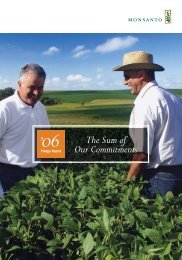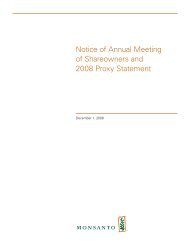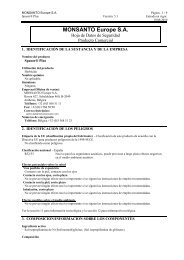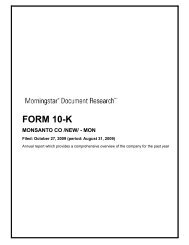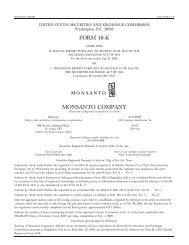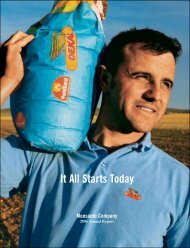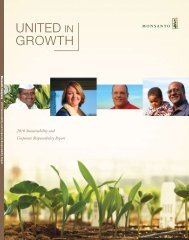You also want an ePaper? Increase the reach of your titles
YUMPU automatically turns print PDFs into web optimized ePapers that Google loves.
IMPACTS OF BT COTTON IN CHINA<br />
HIGHER YIELDS AND NET RETURNS, REDUCED<br />
24, 25<br />
PRODUCTION COSTS AND LABOR INPUTS<br />
Studies released by Pray et al., and Huang<br />
et al., examined the effects of Bt cotton<br />
adoption in China. It was based on farmer<br />
surveys conducted in 1999, 2000, and 2001<br />
in a number of provinces where farmers were<br />
growing Bt and non-Bt cotton.<br />
The results demonstrate that adoption of<br />
Bt cotton increases output per hectare.<br />
Overall, the farmers who grew Bt cotton<br />
reduced the number of pesticide sprays used,<br />
which reduced their production costs. Farmers<br />
also saw increased yields because they had<br />
less damage from the cotton bollworm.<br />
Bt cotton growers had higher revenue<br />
than non-Bt users.<br />
1999<br />
Table 1: Yield Comparison Between Bt and<br />
Non-Bt Cotton<br />
(IN KILOGRAMS PER HECTARE)<br />
Bt cotton Non-Bt cotton<br />
3,371<br />
3,186<br />
2000<br />
1,901<br />
2,941<br />
2001<br />
3,138<br />
3,481<br />
1500<br />
*Average of five provinces in China, 1999-2001 survey data.<br />
4000<br />
Table 2: Average per hectare returns (US$) for all<br />
surveyed farmers (1999-2001)<br />
(NET REVENUE IN DOLLARS PER HECTARE)<br />
Non-Bt cotton Bt cotton<br />
1999 $-6<br />
$351<br />
2000 $-183<br />
$367<br />
2001 $-225<br />
$277<br />
-250 0 1500<br />
The researchers concluded that China’s<br />
experience with Bt cotton offers lessons from<br />
which other farmers in developing countries<br />
can benefit. Chinese farmers found that<br />
growing Bt cotton was profitable. Cotton<br />
growers on small farms in other developing<br />
countries should expect similar gains.<br />
IMPACTS OF BT COTTON IN<br />
SOUTH AFRICA<br />
HIGHER YIELDS, INCREASED REVENUE WITH<br />
REDUCED PESTICIDE SPRAYING 26<br />
A study conducted by Morse et al. analyzed<br />
the economic impact of the adoption of Bt<br />
cotton by resource-poor smallholder farmers<br />
in South Africa (Makhathini area). The study<br />
compared farmer-managed results to field trial<br />
data collected under controlled conditions.<br />
More than 2,200 farmer records were analyzed.<br />
Personal interviews were conducted with<br />
100 farmers, and case studies were made of<br />
32 farmers. Data from three growing seasons,<br />
1998-1999, 1999-2000, and 2000-2001, were<br />
analyzed to compare adopters of Bt cotton<br />
with nonadopters by a number of measures:<br />
yield, total revenue, seed costs, pesticide costs,<br />
spray-labor costs, harvest-labor costs, and gross<br />
margin. In all three growing seasons, adopters<br />
of the Bt seed experienced consistently higher<br />
yields and increased revenue. Bt adopters<br />
had higher seed costs and harvest costs due<br />
to higher yields, but they consistently lowered<br />
their pesticide and spray labor costs.<br />
Adopters of Bt cotton achieved substantially<br />
higher gross margins than nonadopters<br />
across all three seasons (531 to 742 South<br />
African rands, the equivalent of $86 to $93<br />
(U.S.) at the time of harvest) per hectare<br />
depending on the season. The authors<br />
concluded that smallholder farmers employing<br />
more intensive practices benefited most from<br />
the technology.<br />
{ MONSANTO COMPANY 2004 PLEDGE REPORT: PAGES 28-29 }



